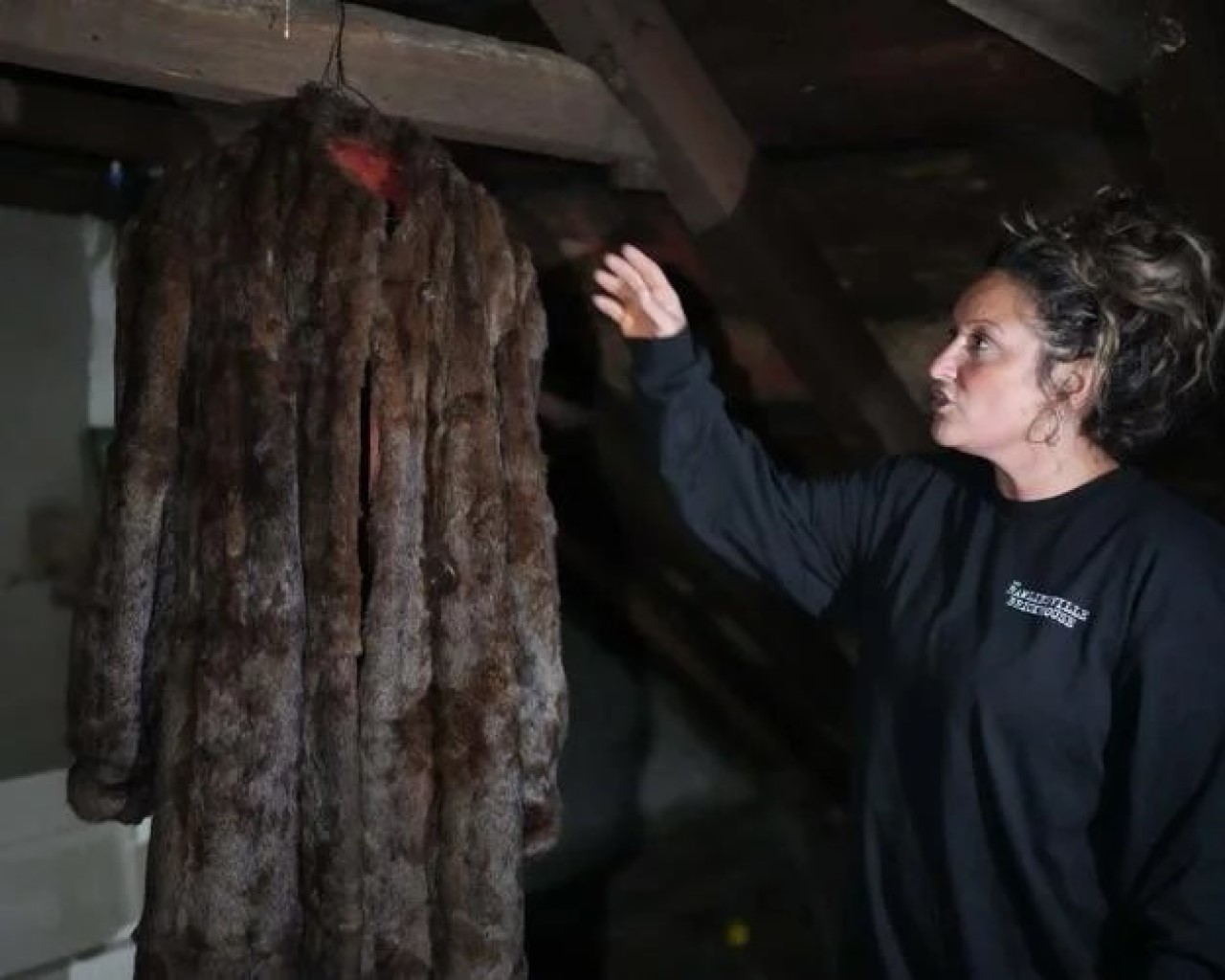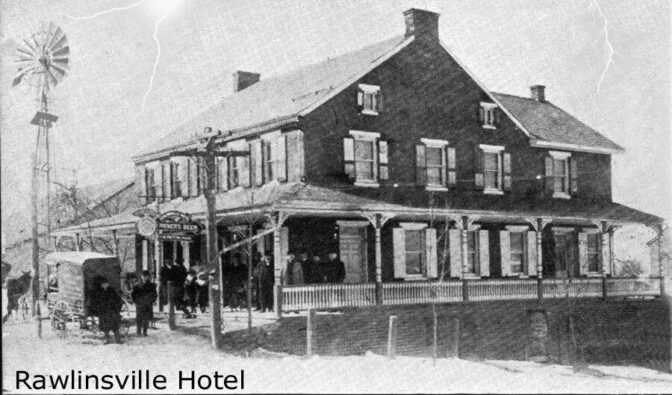
Katie Schatz-Stuart talks about Elizabeth's fur coat in the attic of the Rawlinsville Brickhouse on Monday, Sept. 25, 2023.
Connor Hollinger / | LNP Correspondent

Katie Schatz-Stuart talks about Elizabeth's fur coat in the attic of the Rawlinsville Brickhouse on Monday, Sept. 25, 2023.
Connor Hollinger / | LNP Correspondent

Connor Hollinger / | LNP Correspondent
Katie Schatz-Stuart talks about Elizabeth's fur coat in the attic of the Rawlinsville Brickhouse on Monday, Sept. 25, 2023.
This story is published in partnership with our sister newsroom LNP | LancasterOnline.
There’s a fur coat hanging in the dusty attic of The Rawlinsville Brickhouse. It’s been up there for decades. Katie Schatz-Stuart — who in April bought the circa 1851 Holtwood building with her husband, Robbie Stuart — says the woman who sold them the place told her not to disturb the coat. So did building inspectors, she says. Schatz-Stuart has been informed many times — by multiple people — that the coat belongs to a ghost named Elizabeth and that Elizabeth will make her displeasure known should the coat be removed.
“I’ve heard different things about who this Elizabeth is,” Schatz-Stuart says. “I’ve yet to get the whole story.”
Since she and her husband opened The Rawlinsville Brickhouse in July, they’ve met many onetime regulars of what used to be called The Rawlinsville Hotel. Many had never heard of Elizabeth. Others share stories.
Schatz-Stuart says one tale involves an employee (before her time at the helm) who cussed out Elizabeth while having a bad day only to have a lightbulb explode above her head.
The current prep cook — who Schatz-Stuart says starts each morning by telling Elizabeth to have a good day — heard a crash and found trays seemingly tossed across the floor. Security footage went fuzzy at the pivotal moment, Schatz-Stua
rt says, adding that her managers have also heard footsteps above them while looking at security cameras and seeing nobody was there.
As for herself?
“This was when I was doing demo remodeling. So, it was dusty-dirty. It was just me in there. Stinky. Sweaty. Nothing anywhere that smelled good,” she says. “All of a sudden, I got this massively strong smell of floral perfume. I thought, where in the world is this coming from?”
She kept working.
“A few days later, somebody had posted on our Facebook, ‘Oh, by the way, you’ll know when Elizabeth is in the room because you’ll smell her floral perfume,’ ” she says.
The fur coat’s lining is embroidered with flowers.
They’re not visible unless somebody opens the coat, which Schatz-Stuart does for an LNP | LancasterOnline correspondent and
photographer. She looks nervous.
“This is the most I’ve ever touched it,” she says.
The day’s last rays of already cloud-covered sun are barely making it through the attic window. It’s musty and quiet, a stark contrast to the noisy, yummy-smelling frivolity going on two floors below as families dine and Eagles fans await the start of the game.
“Did you tell them the story about Elizabeth?” general manager Michael Arion says.
“Which story?” Schatz-Stuart replies. “There have been so many.”
Arion nods.
“Originally we were told that she was murdered here or something happened here and she died,” he says. “And then a gentleman came in and … told us the story that his grandfather told him.”
The latter is linked to the Civil War and came from Robert Yeager, 71, whose grandparents owned the hotel from 1945 to 1973.
“The husband went off to war and Elizabeth watched from the (attic) window waiting for him to come home, which he never did,” Yeager says.
He says the coat was in the attic when his grandparents took ownership. His parents would work there some weekends, so Yeager would go to bed upstairs. He vividly recalls the night when he was about 12 years old when he and his brother heard scratching at the window and screamed.
Their mother assured them it was a branch, he says. In the morning, they looked, and there was no branch anywhere close.
“She was just trying to calm us down,” he says. “She knew about Elizabeth.”

Herb Fisher collection, acquired 2012
This undated photo is from the Herb Fisher collection at the Southern Lancaster County Historical Society. “The history of the Rawlinsville Hotel includes a store building, to the left of the hotel, which had an on again, off again business between 1835 and 1875,” states a caption below the buggy in “General Merchandise Stores of Southern Lancaster County, Pa.” That 2019 book by Mike Roth and Stanley White is available at the Quarryville Library, Stoner Decorating in Quarryville, the Southern Lancaster County Historical Society archives and on Amazon.
Unsurprisingly for a structure so old, more than one person expired in or near the hotel.
There was, for example, the schoolteacher who died there “very suddenly” in 1859. Because he had no local relatives, the fraternal group the Order of the Odd Fellows had to “take possession of the remains and … (inter) them in accordance with the usage of the order,” per The Lancaster Examiner.
A 60-year-old farm worker was walking through the hotel’s orchard in 1941 when heart problems caused his demise. His dog “sat vigil over his master for several hours,” which is what attracted the hotel owner’s 12-year-old son to investigate the scene, reported The Lancaster New Era.
And there were close calls.
In 1879, the hotel’s proprietor was helping a Rawlinsville doctor slaughter his hogs when, according to The Semi-Weekly New Era, one of them “seized him by the leg lacerating it in a terrible manner, cutting an artery.”
A later owner was “seized with pleurisy” in 1899 and was not expected to recover, according to the Semi-Weekly New Era. But he did, sold the hotel and died in 1910.
And in 1929 a headline in The Evening News in Wilkes-Barre read: “Second bomb outrage stirs Rawlinsville: Hotel Badly Wrecked but Proprietor and Family Escape Unhurt.”
A porch bomb destroyed boards and “shattered every window in the hotel” just days after someone blew up a nearby Rawlinsville farmer’s shed. The newspaper reported state police working out of Quarryville initially thought the shed incident might have been hunters unhappy with the farmer’s “no trespassing” signs.
“The bombing of the Rawlinsville Hotel, however, has caused police to view the outrages in a different light,” reported that newspaper. “One theory advanced is that both of the bombings were the work of an irresponsible maniac.”
Who was Elizabeth?
Archived newspaper stories appear to shed zero light on anything that might relate to the ghost story. Many details of The Rawlinsville Hotel’s history — from sprained ankles to new dining room wallpaper — got ink. But if anybody was murdered there, it either somehow didn’t make the papers or was worded in a way that makes it hard to find in the archives.
References to Elizabeths appear tangential.
Elizabeth Reese was married to a man who ran the Rawlinsville store when it stood where the hotel’s parking lot is now, according to “General Merchandise Stores of Southern Lancaster County, Pa.” by Mike Roth and Stanley White. But she lived to age 93 and died in 1898 in New Providence, per her obituary.
In 1900 another Rawlinsville shopkeeper’s wife named Elizabeth Fitzkee died at age 35 after being sick with pneumonia for about a week, reported The Semi-Weekly New Era. However, by then, Rawlinsville’s general store was located elsewhere, per the book that does reference the three Civil War-era Rawlinsville Hotel owners. Those owners don’t jibe with a Civil War widow.
Caroline Donovan — the wife of a wealthy Maryland slave trader — bought the hotel at a sheriff’s sale in 1865, the same year the Civil War ended. It was auctioned after an owner named Robert Soulsby ran into financial problems, wrote Roth and White. Donovan leased it out to Soulsby’s son.
Before Soulsby a George Robinson owned the hotel from 1858 to 1863. His history is harder to track, in part because there were multiple George Robinsons in the area back then. But as late as 1880, a George Robinson was still making news for getting into a brawl outside the Odd Fellows Hall in Rawlinsville over an old grudge. Neither the older or younger Soulsby nor Robinson had wives named Elizabeth.
“I thought it was the Civil War, but maybe I got that part wrong,” Yeager says. “Maybe World War I? I don’t know.”
World War II might make more sense, given the style of the coat. Marc Kaufman, who heads a New York City furrier group that’s been around since 1870, took a quick look at cell phone shots of the coat and estimated maybe 1930s or ’40s.
Whenever the story might have taken place, Yeager does know it helped him in his youth to deal with unexplained sights and sounds.
“I actually went up (to the attic as a teen) and talked to her. I didn’t get an answer. But I talked to her,” he says. “At that point I wasn’t afraid, knowing what had happened and realizing she wasn’t a bad ghost.”
He no longer visits the attic but still stops by the bar.
“It’s beautiful what they did to the place, Katie and Robbie,” Yeager says. “They came in there and did a super job. So, I go and reminisce.”
Some who have seen the coat over the decades remark on how it appears always dust-free. And the coat does have a shine. There’s damage to one cuff, but it’s missing the dust and cobwebs abundant elsewhere in the attic.
That’s not typical, says Linda DiBartolo, co-owner of Tannery Antiques, a New Holland store that specializes in taxidermy. She’s intrigued when told about Rawlinsville.
“Dust and dirt it should show — especially if it’s been hanging there for so long,” DiBartolo says. “You would expect it to show age from being up there. Being hot. Being cold. It should show all that — unless it’s got a caretaker.”
So, there’s no sort of dirt resistance specific to furs?
“Nope,” DiBartolo says. “There’s no explaining that one away.”
Schatz-Stuart says she’s been told that sometime in the past someone decided it was time to get rid of it.
“I don’t even know who it was, but I’m told she put it in her car to donate it,” she says. “She got to, I think about Willow Street, and supposedly the coat was levitating in her back seat. She turned around and brought the coat back … I’m not really sure I believe all that.”
But Schatz-Stuart has no intention of ever removing the coat from the building.
She did buy an antique dress form and placed it in a dining room corner as a possible way to display the coat one day.
“I bought the dress form a while ago,” she says. “People will ask, ‘Are you moving the coat?’ ”
Not yet, she tells them.
“We’re going to be open and running for quite a while, at least a year” she says. “And then I will move it down. And if crazy stuff starts happening? I’m going to put it right back.”
The days of journalism’s one-way street of simply producing stories for the public have long been over. Now, it’s time to find better ways to interact with you and ensure we meet your high standards of what a credible media organization should be.